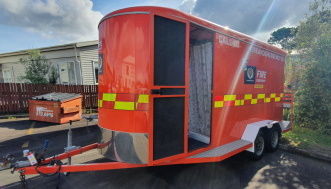Resources
People
The Unit's most important resources are its members who, coming from all walks of life and fulltime occupations, bring their talents and experience to help make a team which is successful in all the activities we undertake. But it's the contribution of their time that is most valued, whether on the fireground, maintaining radio watch, manning fire safety displays, or training. And each member attends numerous training sessions. The newest recruit learns the basics in a structured training programme while those older hands refresh and exercise to remain proficient. Safety of the individual and one's colleagues, is paramount, so constant training means that our most valuable asset, our people, are out there and out of danger with minimal risk.
Vehicles
The Auckland Operational Support Unit operates a fleet of 4 vehicles and 1 trailer (and supports the deployment of other Fire and Emergency resources from time-to-time). The vehicle roster ensures that there is always 1 vehicle manned 24 hours a day, every day of the year, as well as a second vehicle manned on weeknights, and every weekend.
 |
Operational Support 1 - Mercedes-Benz Vito Commissioned in October 2020, this emergency response vehicle is manned by rostered drivers, usually arranged so that this van and one of the Mitsubishi Canters shares calls across the Greater Auckland. It can respond with a driver and up to 4 crew and has a customised tray to provide for the unique payload - equipment and facilities - required for Operational Support services. |
 |
Operational Support 2 - Mitsubishi Canter This vehicle and Operational Support 3 share the 'second vehicle' role, with one of them rostered on nights and weekends to a duty driver. Operational Support 2 can transport a driver and 4-5 crew members. When unmanned it is based at either Balmoral or Avondale stations. |
 |
Operational Support 3 - Mitsubishi Canter Like Operational Support 2, this vehicle is usually rostered to a duty driver on nights-and-weekends. The two Mitsubishi appliances are fitted with a heavy-duty towbar and are favoured for towing requirements, whether the Ablutions trailer, or other FENZ resources (such as the comms caravan) to events or emergencies. When unmanned, this vehicle may be found at Otahuhu, Balmoral or Avondale stations, subject to operational requirements. |
These 3 vehicles generally respond with lights and siren and carry a range of equipment most used by Operational Support at incidents, including road cones, road signs, generator/lighting set, salvage equipment, emergency helipad lighting, and light refreshments. Their extensive radio communication equipment, with fireground radios and links to both Fire and Emergency and other emergency services, means that at major or long-duration incidents they can deputise as the Incident Command Vehicle.
 Operational Support 4  1971 Ford  1957 Bedford |
Operational Support 4 - Iveco Eurocargo (Canteen) A 2002 Iveco, the canteen automatically responds the Third Alarm calls and greater, but it is also welcomed at other long duration jobs such as bush and forest fires. The Canteen, a mobile kitchen, mostly serves hot and cold drinks with light refreshments, but it always carries 100-plus frozen meals which can be prepared either in the giant microwave oven or on one of two gas stoves.
There are also barbecue facilities to cater for larger numbers at a major operation, or for social events.
For decades the Unit's members have driven the Canteen to calls, and manned it once on the fireground. The first was a 1957 Bedford (ex Salvage Tender) which was converted and commissioned in 1977. It was replaced in 1981 by a 1971-model Ford D Series, a truck which had been a mobile training resource out of Wellington, taking de-centralised training to many outlying Brigades throughout the country. It was altered for canteen duties and served for 20 years. In 1999 Operational Support took over its administration as well as its operations and shortly after it was upgraded to an Urgent Response Vehicle with lights and siren fitted. In early 2003 work began to replace the rear body on a brand new Iveco chassis, enlarged, improved, repainted. It was commissioned in mid 2003 and is based at Balmoral station. |
Equipment
 |
Pagers All members have a pager to alert them to callouts. The address and brief details are sent out at the same time as appliances are despatched, so Operational Support can make a quick response. Any further messages seeking reinforcements, etc can be sent by one of a group of members who are rostered on "Radio Comms Duties". These members are also in communication with those responding to calls, and at calls, by UHF radio on Operational Support channels. |
 |
Radios All members are issued with a UHF hand-held radio, connected to a digital radio network that covers the Unit's area of operations. The channels are exclusively for Operational Support, thus members can converse with the rostered Radio Operator and vice versa, and with others who are responding to calls. Once on the fireground, members change to a Simplex channel to co-ordinate Unit activities. |
 |
Personal In addition to the equipment carried on our operational vehicles, most members carry in their private vehicles a few aids to enable them to carry out tasks immediately as they arrive on the fireground. They may typically carry road cones to close roads or to create a safety zone around fireground operations, white "no-go" tape to create cordons and, sometimes, road signs. A good flashlight is essential. Members have portable flashing red lights for the roof of their cars, displayed when on the fireground to warn motorists of the dangers created by the emergency or to reinforce road closures. |




